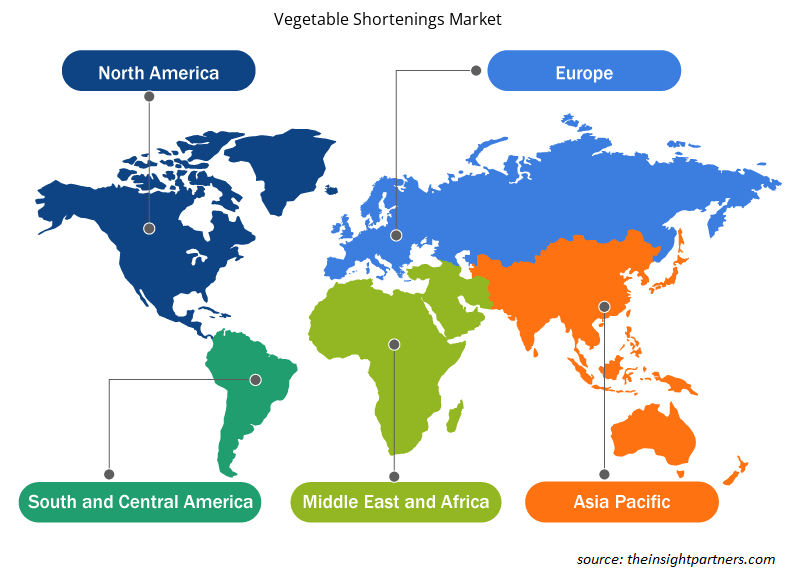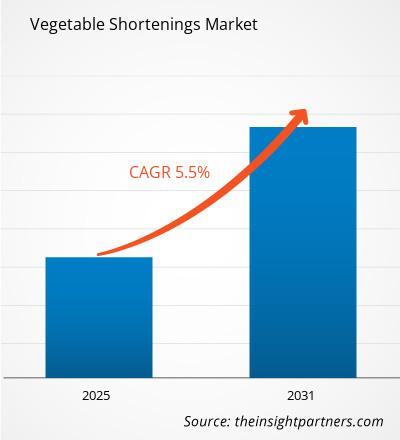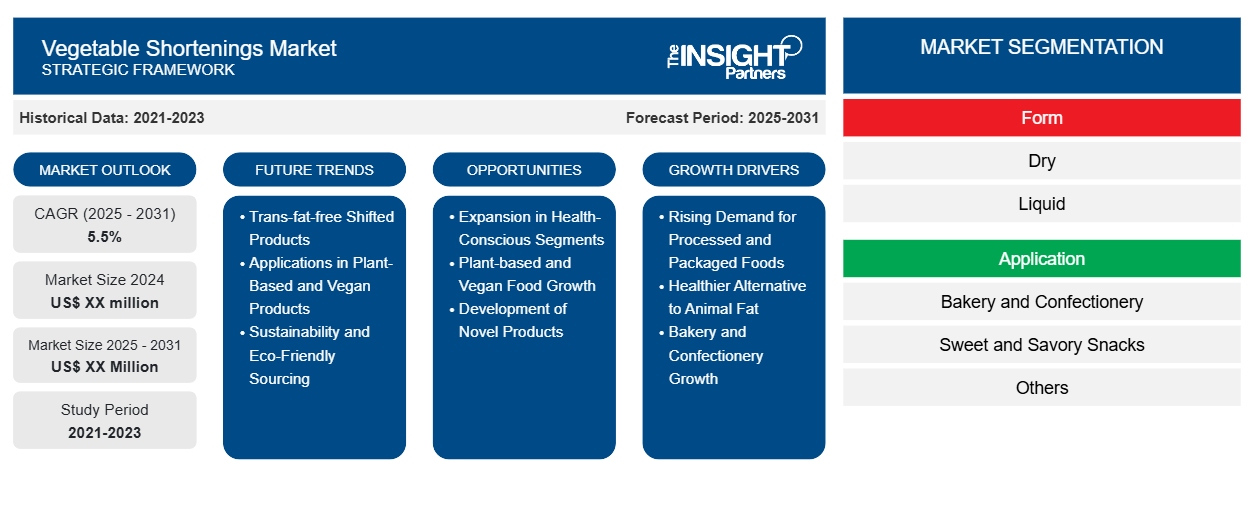Si prevede che il mercato degli strutti vegetali registrerà un CAGR del 5,5% dal 2023 al 2031, con una dimensione di mercato in espansione da XX milioni di dollari nel 2023 a XX milioni di dollari entro il 2031.
Il rapporto è segmentato per forma (secco, liquido). Il rapporto presenta inoltre analisi basate sull'applicazione (panetteria e dolciumi, snack dolci e salati e altri). L'analisi globale è ulteriormente suddivisa a livello regionale e nei principali paesi. In termini geografici, il mercato è suddiviso in Nord America, Europa, Asia Pacifico, Medio Oriente e Africa e Sud e Centro America). Il rapporto offre il valore in USD per l'analisi e i segmenti di cui sopra.
Scopo del rapporto
Il report Vegetable Shortenings Market di The Insight Partners mira a descrivere il panorama attuale e la crescita futura, i principali fattori trainanti, le sfide e le opportunità. Ciò fornirà spunti a vari stakeholder aziendali, come:
- Fornitori/produttori di tecnologia: per comprendere le dinamiche di mercato in evoluzione e conoscere le potenziali opportunità di crescita, consentendo loro di prendere decisioni strategiche informate.
- Investitori: condurre un'analisi completa delle tendenze in merito al tasso di crescita del mercato, alle proiezioni finanziarie del mercato e alle opportunità esistenti lungo la catena del valore.
- Enti di regolamentazione: regolamentano le politiche e le attività di controllo sul mercato allo scopo di ridurre al minimo gli abusi, preservare la fiducia degli investitori e sostenere l'integrità e la stabilità del mercato.
Segmentazione del mercato degli strutti vegetali
Modulo
- Asciutto
- Liquido
Applicazione
- Panetteria e pasticceria
- Snack dolci e salati
- Altri
Personalizza questo report in base alle tue esigenze
Riceverai la personalizzazione gratuita di qualsiasi report, comprese parti di questo report, o analisi a livello nazionale, pacchetto dati Excel, oltre a usufruire di grandi offerte e sconti per start-up e università
-
Scopri le principali tendenze di mercato in questo rapporto.Questo campione GRATUITO includerà analisi di dati che spaziano dalle tendenze di mercato alle stime e alle previsioni.
Fattori trainanti della crescita del mercato degli strutti vegetali
- Domanda crescente di alimenti trasformati e confezionati: poiché i consumatori hanno una tendenza crescente a preferire cibi pronti e pronti, la domanda di grasso vegetale è in aumento. È un ingrediente comune che si trova nei prodotti da forno, negli snack o in altri alimenti trasformati per migliorare la consistenza, la stabilità e altre efficienze nella durata di conservazione.
- Alternativa più sana al grasso animale: la crescente consapevolezza della salute e del benessere ha reso lo strutto vegetale popolare come alternativa al grasso animale. Questo tipo di consumatore lo preferisce come opzione vegetale e senza grassi trans per ridurre il colesterolo e i grassi saturi.
- Crescita di prodotti da forno e dolciumi: la domanda di grasso vegetale è determinata dall'espansione globale dei settori dei prodotti da forno e dolciumi. Questo perché viene utilizzato efficacemente per produrre vari prodotti da forno come pasticcini, torte e biscotti in cui è richiesta una consistenza leggera e friabile, il tutto di fronte alla crescente preferenza dei consumatori verso prodotti da forno di qualità.
Tendenze future del mercato degli strutti vegetali
- Prodotti modificati senza grassi trans: in effetti, con l'avvento della cultura attenta alla salute, lo strutto vegetale è più incline all'assenza di acidi grassi trans nella formulazione del prodotto, per supportare la domanda di alternative più sane e rispettose del cuore, bussando alla porta dei prodotti a etichetta pulita.
- Applicazioni nei prodotti vegani e a base vegetale: la portata dello strutto vegetale continua ad aumentare con la tendenza crescente verso diete a base vegetale. È davvero un ingrediente importante nella produzione di prodotti vegani e senza latticini perché può creare una soluzione versatile in un'alternativa non grassa di origine animale e soddisfare davvero la domanda di alternative a base vegetale presenti in prodotti da forno, pasticcini e snack.
- Sostenibilità e approvvigionamento eco-compatibile: oggi, la consapevolezza ambientale ha reso la tendenza a rifornirsi di grasso vegetale da piante coltivate in modo sostenibile. Ciò ha fatto sì che quasi tutti nella comunità prestino attenzione al metodo di approvvigionamento e produzione eco-compatibile attraverso cui viene prodotto il grasso per garantire un impatto ambientale minore.
Opportunità di mercato per gli strutti vegetali
- Espansione nei segmenti attenti alla salute: ci sono diversi segmenti correlati al consumo sano e alla crescente domanda di grassi sani, che lasciano un assortimento di opportunità per i marchi che cercano di realizzare forme di grasso vegetale a basso contenuto di grassi trans e non idrogenate. I consumatori finali sono in genere attenti alla salute e i due principali settori influenzati da questa domanda sono i prodotti da forno e gli snack, attraverso i quali i due mercati ripuliscono i loro grassi
- Crescita degli alimenti vegani e a base vegetale: l'alimentazione a base vegetale rappresenterebbe un'opportunità molto interessante per i produttori di grassi vegetali di espandere i propri mercati e quindi introdurre i loro diversi grassi nei prodotti da forno, nei dolci e così via a base vegetale, servendo così un numero crescente di vegani.
- Sviluppo di nuovi prodotti: una di queste opportunità è l'innovazione dello strutto vegetale utilizzando diversi ingredienti funzionali come gli acidi grassi omega-3 o gli antiossidanti. Ciò soddisferebbe le crescenti richieste dei consumatori di prodotti alimentari fortificati e ricchi di nutrienti, aumentando l'attrattiva dello strutto vegetale per applicazioni orientate alla salute.
Approfondimenti regionali sul mercato degli strutti vegetali
Le tendenze regionali e i fattori che influenzano il Vegetable Shortenings Market durante il periodo di previsione sono stati ampiamente spiegati dagli analisti di Insight Partners. Questa sezione discute anche i segmenti e la geografia del Vegetable Shortenings Market in Nord America, Europa, Asia Pacifico, Medio Oriente e Africa e Sud e Centro America.

- Ottieni i dati specifici regionali per il mercato degli strutti vegetali
Ambito del rapporto di mercato sugli strutti vegetali
| Attributo del report | Dettagli |
|---|---|
| Dimensioni del mercato nel 2023 | XX milioni di dollari USA |
| Dimensioni del mercato entro il 2031 | XX milioni di dollari USA |
| CAGR globale (2023-2031) | 5,5% |
| Dati storici | 2021-2022 |
| Periodo di previsione | 2024-2031 |
| Segmenti coperti |
Per modulo
|
| Regioni e Paesi coperti |
America del Nord
|
| Leader di mercato e profili aziendali chiave |
|
Densità degli attori del mercato degli strutti vegetali: comprendere il suo impatto sulle dinamiche aziendali
Il mercato degli accorciamenti vegetali sta crescendo rapidamente, spinto dalla crescente domanda degli utenti finali dovuta a fattori quali l'evoluzione delle preferenze dei consumatori, i progressi tecnologici e una maggiore consapevolezza dei benefici del prodotto. Con l'aumento della domanda, le aziende stanno ampliando le loro offerte, innovando per soddisfare le esigenze dei consumatori e capitalizzando sulle tendenze emergenti, il che alimenta ulteriormente la crescita del mercato.
La densità degli operatori di mercato si riferisce alla distribuzione di aziende o società che operano in un particolare mercato o settore. Indica quanti concorrenti (operatori di mercato) sono presenti in un dato spazio di mercato in relazione alle sue dimensioni o al valore di mercato totale.
Le principali aziende che operano nel mercato degli strutti vegetali sono:
- Al-Khaleej Industries Sdn Bhd.
- Azienda Archer Daniels Midland
- Associato British Foods plc
- Bunge North America, Inc.
- IFFCO
Disclaimer : le aziende elencate sopra non sono classificate secondo un ordine particolare.

- Ottieni una panoramica dei principali attori del mercato degli strutti vegetali
Punti di forza chiave
- Copertura completa: il rapporto copre in modo completo l'analisi di prodotti, servizi, tipologie e utenti finali del mercato degli strutti vegetali, fornendo una panoramica olistica.
- Analisi degli esperti: il rapporto è compilato sulla base della conoscenza approfondita di esperti e analisti del settore.
- Informazioni aggiornate: il rapporto garantisce la pertinenza aziendale grazie alla copertura di informazioni recenti e tendenze nei dati.
- Opzioni di personalizzazione: questo report può essere personalizzato per soddisfare le esigenze specifiche del cliente e adattarsi in modo appropriato alle strategie aziendali.
Il rapporto di ricerca sul Vegetable Shortenings Market può, quindi, aiutare a guidare il percorso di decodificazione e comprensione dello scenario del settore e delle prospettive di crescita. Sebbene possano esserci alcune preoccupazioni valide, i vantaggi complessivi di questo rapporto tendono a superare gli svantaggi.
- Analisi storica (2 anni), anno base, previsione (7 anni) con CAGR
- Analisi PEST e SWOT
- Valore/volume delle dimensioni del mercato - Globale, Regionale, Nazionale
- Industria e panorama competitivo
- Set di dati Excel
Report recenti
Testimonianze
Motivo dell'acquisto
- Processo decisionale informato
- Comprensione delle dinamiche di mercato
- Analisi competitiva
- Analisi dei clienti
- Previsioni di mercato
- Mitigazione del rischio
- Pianificazione strategica
- Giustificazione degli investimenti
- Identificazione dei mercati emergenti
- Miglioramento delle strategie di marketing
- Aumento dell'efficienza operativa
- Allineamento alle tendenze normative























 Ottieni un campione gratuito per - Mercato degli strutti vegetali
Ottieni un campione gratuito per - Mercato degli strutti vegetali